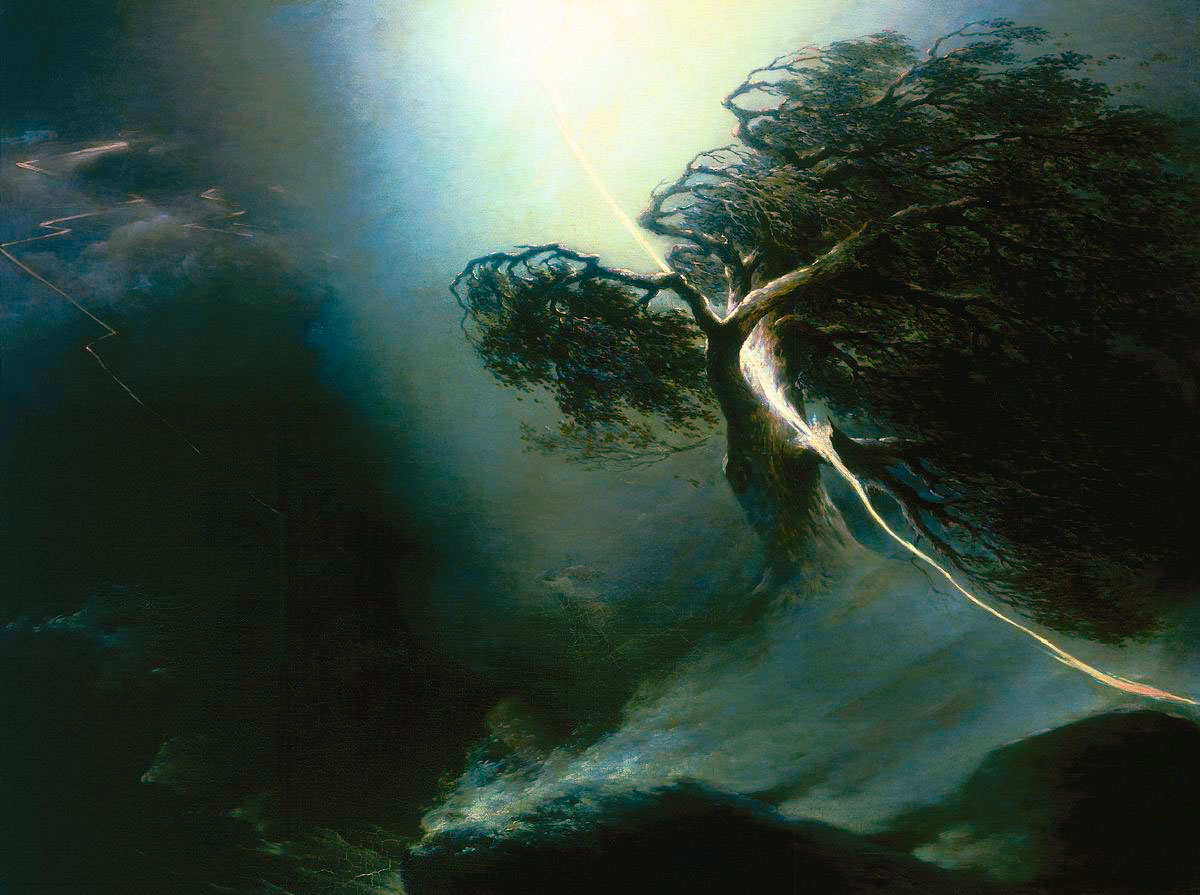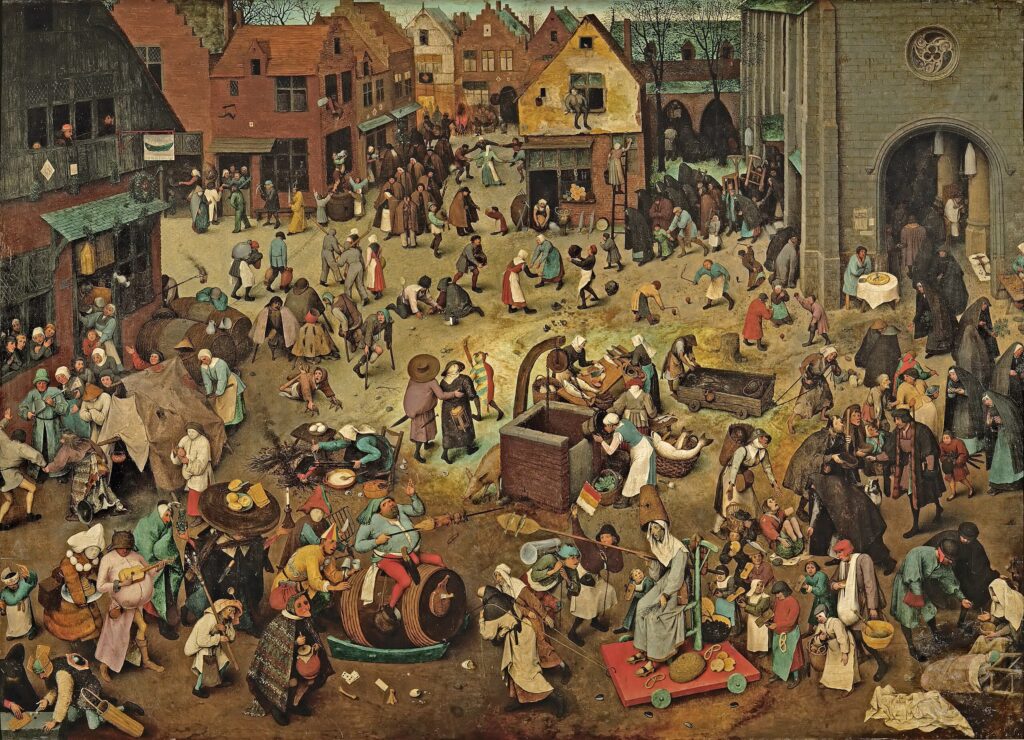Maxim Vorobiev was a 19th century Russian painter who was born in Saint Petersburg in 1787. He was one of the most celebrated landscape artists of his time and was known for his ability to capture the beauty and grandeur of Russia’s natural scenery. Vorobiev’s journey to artistic success was not an easy one, and he had to overcome several challenges before he could establish himself as an artist of note.
One of the most notable paintings that Vorobiev created during his illustrious career is “Oak Fractured By a Lightning. Allegory On the Artist’s Wife Death” (1842). This painting is a poignant expression of the artist’s personal loss, and it offers a window into the emotional turmoil and grief that he was grappling with.
The Painting
The painting features a mature Oak tree that has been struck by lightning. The trunk of the tree is shattered into multiple pieces, with a large section having split into two. The branches and foliage of the tree are splayed out in all directions, as if in agony. The background of the painting depicts a stormy sky, with dark clouds looming over the horizon.
The painting was created in the aftermath of the death of Vorobiev’s wife. Vorobiev’s wife had passed away in 1824, leaving him devastated and grief-stricken. In some ways, the painting can be seen as an allegorical expression of the artist’s emotional and mental state at the time.
A Master in Landscapes
The painting is a masterful example of Vorobiev’s skill as a landscape painter. The level of detail and realism in the portrayal of the Oak tree is exceptional. The lightning bolt that has struck the tree is depicted with a bright white light that illuminates the surroundings and the fallen branches. The use of light and shadow in the painting is also noteworthy. The dark, brooding clouds in the background create a sense of foreboding and despair, while the light that emanates from the lightning bolt offers a glimmer of hope.
Fragility of Life
While the painting is undoubtedly a stunning depiction of natural scenery, it is the emotion that it conveys that truly sets it apart. The shattered Oak tree is a powerful symbol of the fragility of life, and the artist’s own grief and sense of loss are palpable in the painting. The use of allegory to express the artist’s emotions is a testament to Vorobiev’s creativity and skill as a painter.
Vorobiev’s journey to artistic success was a challenging one. As a young man, he was not initially interested in pursuing a career in the arts. Instead, he studied math and science, hoping to become an engineer. However, fate had other plans for him. In 1807, while working as a tutor, he met a group of artists who recognized his talent and encouraged him to pursue art professionally. This encounter changed the course of Vorobiev’s life, and he soon began studying at the Imperial Academy of Arts in Saint Petersburg.
Early Setbacks
Despite his talent, Vorobiev faced numerous setbacks in his early career. He struggled to gain recognition for his work and often found himself overshadowed by other, more established artists. The art scene in Russia at the time was highly competitive and political, with artists often relying on connections and patronage to advance their careers. Vorobiev, who lacked influential connections, found it difficult to make a name for himself.
Nevertheless, Vorobiev persisted. He continued to create paintings that showcased his talent and unique perspective, and gradually began to gain recognition for his work. His paintings of natural scenery were particularly well-received and became his trademark style. In 1814, Vorobiev was awarded the title of Academician of the Imperial Academy of Arts, cementing his place as one of the leading artists of his time.
Despite achieving success as an artist, Vorobiev’s personal life was marked by tragedy. His wife’s death in 1824 left him devastated, and he struggled to come to terms with his loss. The creation of “Oak Fractured By a Lightning. Allegory On the Artist’s Wife Death” is a poignant testament to the depths of his grief and the pain that he endured.
A Fitting Tribute
The painting is a fitting tribute to Vorobiev’s wife. The Oak tree, which is one of the longest-lived tree species, represents longevity and strength. Its shattered form, however, is an expression of the inevitability of mortality. The lightning bolt, which is known for its destructive power, serves as a metaphor for the suddenness and finality of death. Together, these elements create a powerful visual statement about the fragility of life and the need to cherish the moments that we have.
Today, “Oak Fractured By a Lightning. Allegory On the Artist’s Wife Death” is regarded as one of Vorobiev’s most significant works and a masterpiece of Russian landscape painting. The painting is housed in the collection of the State Tretyakov Gallery in Moscow, where it continues to be admired by art lovers and historians around the world.
Conclusion
“Oak Fractured By a Lightning. Allegory On the Artist’s Wife Death” is a powerful and poignant expression of the artist’s personal loss and grief. Through his masterful use of allegory and symbolism, Vorobiev was able to convey the emotional turmoil that he was experiencing in the aftermath of his wife’s death. The painting is a testament to Vorobiev’s skill as a landscape painter and a poignant reminder of the fragility of life.





